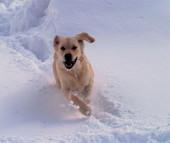 As frigid weather continues to drag on here in the northeast, most of us take precautions to keep ourselves and our children safe and warm. But many forget that our four-legged family members are experiencing the same environmental factors. Here are some important tips to keep your pets safe and happy through these colder months.
As frigid weather continues to drag on here in the northeast, most of us take precautions to keep ourselves and our children safe and warm. But many forget that our four-legged family members are experiencing the same environmental factors. Here are some important tips to keep your pets safe and happy through these colder months.
While larger dogs with thicker coats can handle colder temperatures better than smaller short-haired dogs, hypothermia can still set in if they spend too much time outside. We recommend keeping your furry friend furry. If you routinely have your groomer perform a shave-down, have him or her leave the fur a little longer at this time of year. If you have a short-haired dog, consider dressing them in a coat or sweater before they face the elements. And be sure to limit time outside, especially on frigid days.
Feet, ears and tails are particularly susceptible to frostbite, while longer hair breeds can develop icicles or snowballs in their fur. If you get your dog groomed ask the groomer to trim between the paw pads, or, alternatively, you can do it yourself with a hair clipper. When your dog comes in from romping around, remember to dry him thoroughly and give him a careful inspection, as wounds also may have occurred from exposure to snow or ice.
dog-snow2Dogs that spend the majority of their lives outside will be more likely to be acclimatized to cold weather than one that lives in an apartment in Manhattan. Still, to keep them safe, be sure to provide a good warm, solid shelter. Dog houses should be insulated and protected from the wind and ideally elevated off the ground to minimize heat loss. In addition, good, thick bedding (such as hay) is a necessity and should be changed regularly.
Thin ice
During the winter months, the number of lost dogs rises. When everything is covered with snow and ice, familiar areas may look and smell different and it’s easy for them to get disoriented. Therefore, make certain that your dog has identification on him at all times, either through tags or a registered microchip. It’s amazing how many dog owners fail to register their information, rendering the chip worthless.
In addition, keep your dogs off away from frozen lakes and ponds. They cannot read the signs that read, “thin ice,” so avoid these potentially deadly areas.
Every winter many dogs are rushed to their vets for ingestion of antifreeze, the product used to winterize our cars, RV’s and boats. Ethylene glycol is the main component of many types of antifreeze and has a sweet taste and smell. Unfortunately, it is also highly toxic to dogs. After ingestion, signs of poisoning can appear within an hour, with a high probability of kidney failure and death if animals are not treated immediately. If you use products containing ethylene glycol, make certain that your dogs away from these areas and remember to thoroughly clean up all spills. In addition, consider using products containing propylene glycol, which offers a safer alternative.
Ice melt
Another chemical used in the winter that can be a hazard to dogs is salt or ice melt. It is commonly used on roads, driveways and sidewalks to melt ice or prevent ice buildup, or as part of a snow removal routine. These products can be very irritating to your pet’s feet and skin. (This is another reason to check their feet when they’ve come inside from the snow.) Consider pet-safe products that will melt ice but will be easier on their feet, as well as small protective booties.
For many of us, passing the winter months with a furry friend by a fire is a wonderful experience. While dogs are attracted to the heat and flickering of the flames, it is critical that your fireplace bepet proofed. Use wire screens or glass doors to protect yourself and your pet from being burned or possibly even setting your home on fire. If you use a space heater be sure to secure it in an area where your dog cannot reach it unattended.
Older canines
Senior dogs are especially at risk during the colder months. These old-timers lack the muscle mass and insulation that their younger counterparts have to protect them in colder conditions. Moreover, as with humans, older dogs tend to suffer from conditions such as arthritis, which can make them more uncomfortable when the temperature drops. Having sore, stiff joints also makes it difficult for them to get around in snow and ice, thus increasing their risk of slipping and falling. Limit their time outside, shovel a safe path for them and use pet-friendly ice melts to help avoid injuries.
If your older dog seems to be experiencing pain or discomfort, consult your veterinarian. Whatever you do, DO NOT give them your own medications. Many human arthritis drugs are unsafe for dogs. Your vet can recommend dog-safe medications or other arthritis treatments.
As with most things in life, apply common sense to the treatment and handling of your dog. Just as with our children, they may want to romp and roll in the snow, but it is our job to keep these activities safe. Know your dog’s limitations and remember that just because they have fur coats doesn’t mean they’re impervious to the elements. By taking some simple precautions we can keep our dogs safe during these colder months of the year.
